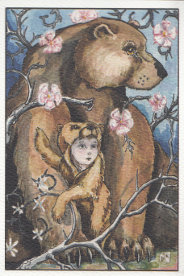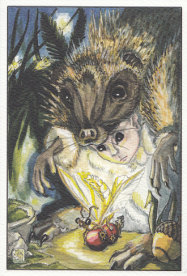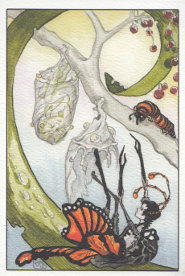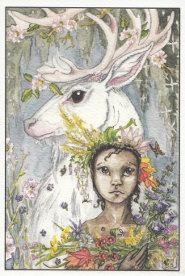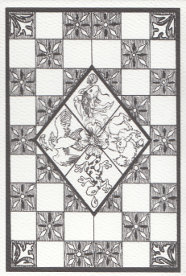Stolen Child Tarot Deck Review
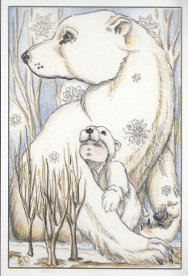
The Stolen Child Tarot is a self-published labour of love from Monica Knighton, creator of the Tarot of the Dead. It's a 22 card deck, inspired by a Yeats poem of the same name.
Deck Type: Tarot Deck Cards: 22
Creators: Monica Knighton
Publisher: Self Published 2012
Retailers
See Price at Etsy.comStolen Child Tarot Review by Bonnie Cehovet
The Stolen Child
William Butler Yeats (online-literature.com)
WHERE dips the rocky highland
Of Sleuth Wood in the lake,
There lies a leafy island
Where flapping herons wake
The drowsy water rats;
There we've hid our faery vats,
Full of berrys
And of reddest stolen cherries.
Come away, O human child!
To the waters and the wild
With a faery, hand in hand,
For the world's more full of weeping than you can understand.
Where the wave of moonlight glosses
The dim gray sands with light,
Far off by furthest Rosses
We foot it all the night,
Weaving olden dances
Mingling hands and mingling glances
Till the moon has taken flight;
To and fro we leap
And chase the frothy bubbles,
While the world is full of troubles
And anxious in its sleep.
Come away, O human child!
To the waters and the wild
With a faery, hand in hand,
For the world's more full of weeping than you can understand.
Where the wandering water gushes
From the hills above Glen-Car,
In pools among the rushes
That scarce could bathe a star,
We seek for slumbering trout
And whispering in their ears
Give them unquiet dreams;
Leaning softly out
From ferns that drop their tears
Over the young streams.
Come away, O human child!
To the waters and the wild
With a faery, hand in hand,
For the world's more full of weeping than you can understand.
Away with us he's going,
The solemn-eyed:
He'll hear no more the lowing
Of the calves on the warm hillside
Or the kettle on the hob
Sing peace into his breast,
Or see the brown mice bob
Round and round the oatmeal chest.
For he comes, the human child,
To the waters and the wild
With a faery, hand in hand,
For the world's more full of weeping than he can understand.
I have included Yeat’s poem, in its entirety, because this poem was the inspiration for the “Stolen Child Tarot”. Knighton (also author/artist for the “Tarot of the Dead”) designed the imagery in this deck without the use of man-made objects, She notes on her first Kickstarter Project page for this deck that a crown might be represented by antlers, or an animals form could represent the clothing for a human station. There are also no adult figures in this deck – the figures represent changeling children that have embraced different parts of the natural world. In speaking with Monica, she noted that the second theme in this deck is one of emphasizing the quaternary and the four elements repeatedly in imagery and more subtle ways. The focus here is on a geometric square, its stability, manifestation, and the earth … with special emphasis on the earth.
This is a Limited Edition deck (500 decks printed) which, according to Knighton’s Kickstart page, will not be reprinted until all 78 cards have been done. The illustrations in this deck are done with colored ink and watercolor, and have shading and detail that do not reproduce with a good quality with online print on demand services – which is why she choose to work through Kickstarter. By working with Kickstarter, Knighton was able to work with a local (to her) printer, utilizing a profession four color process that accurately reproduces the color and detail of the originals.
I found Kickstarter very easy to work with. Knighton was very clear about what was included with each level of pledging, and there were plenty of updates so that we all knew where she was in the process. That was something that I very much appreciated!
Rather than including a printed book (LWB) at added expense, Knighton went the route of creating a beautiful PDF download entitled “A Field Guide to the Stolen Child Tarot”, which includes full color thumbnails of each of the cards, along with interpretations. From the Field Guide:
9 The Hermit
The Hermit is willing to let go and explore the unknown for its own sake. The illumination of the bug could be a beacon to draw others of its own kind or a warning to scare predators away. Pure Science, Pure Research, Curiosity, Wisdom, Advanced Age, Leaving ones comfort zone, Humility vs. One who does not suffer fools, Silence, Asceticism.
There are 22 cards, plus two blank cards, and two title cards (one of which is signed and numbered). They come packaged in handmade art paper portfolio, with no two alike! Mine came with a beige inner wrapping, and a forest green outer wrapping, held together with slender twine. Beautifully done!
The cards are 3 ¼” by 4 5/8”. The card backs show a ¼” white border, followed by a thin black border. There is a pattern between white squares and illustrated squares that if you move back from the card a bit you will see forms a series of squares. The illustrated cards in the four corners show a budding leaf, to emphasize the number four. The other illustrated squares show an open blossom with four white petals and four black petals – again, to emphasize the number four. The center of the card shows a four petaled dogwood blossom in the center (matching he blossoms on the World card), with illustrations representing he four suits surrounding it (Earth/Acorn, Air/Feather, Water/Shell, Fire/Flame). Please note: no specific compass point arrangement was held in mind when placing the images, because different systems place the elements in different places.
The card faces show a ¼” white border. followed by a thin black border. The artwork is colored ink and watercolor, with a very gentle sense to them. Nature and animals predominate, with the faces of all of the figures portrayed as changeling children (there are no adult figures in this deck). There are no titles on the cards, but I think you will find that the imagery carries the archetypal theme nicely.
The Fool shows a baby, seated in nature, one hand up to his face, smiling delightedly as four hummingbirds (representing the four points of the quaternary) flit around him.
The Lovers pictures bats pollinating plants in nature – they are so adorable, hanging upside down and looking so very innocent!
The Magician shows a laughing changeling, dressed as a fox. His hands are thrown up in the air, and he is having a grand time! All four elements are represented here, and at the bottom of the card are two adorable little mice!
Temperance shows the face and arms of a changeling underwater, watching the scene in front of him. The represents the junction between land, or material life, and water, or the unconscious, spiritual life (represented by the frog, that goes onto land to give birth, and then returns to the water).
The Devil is depicted as a snake, with two rats sitting in front of it.
Justice shows a changeling, in the center of a field, wearing antlers (symbolizing station and authority) The regimented society of the bee world is represented here in the form of honeycombs, and the bees themselves.
I absolutely adore both the Empress and the Emperor cards, which mirror each other. The Empress shows a brown bear, facing the right hand side of the card. In between her front paws stands a changeling, also focused towards the right hand side of the card. Surrounded by flowers, she is our creative source.
The Emperor shows a white (polar) bear, in a barren landscape, facing the left hand side of the card. Knighton notes that as the King sits on a square to rule, the polar bear literally sits on top of the world. Leaning against his left front paw is a changeling, which is also focused to the left hand side of the card.
The Hermit tugs at my heartstrings! Here we see a changeling, in animal furs with a human face, peering out at two bugs in the center of the illustration. What wisdom will he find here? Is it meant to draw like kind together, or to scare predators away?
Judgment shows a tree branch, with cocoons on it. Along the branch we see a caterpillar, looking down on a butterfly that has just emerged from its cocoon.
In the World we see a changeling, looking straight out at us, with a cornucopia in its arms. The cornucopia represents the world. Behind the changeling we see a white stag, looking to the left hand side of the card. The quaternary is evoked in the four petaled dogwood blossoms.
This is an incredible deck, and, while not a beginner’s deck, is really very easy to read with! I love the earth connection, and will push maneuver my way to the front of the line to purchase the 78 card version when it comes out at all costs!
© Bonnie Cehovet
Stolen Child Tarot Review by Morrigann
When I learnt thanks to Aeclectic Tarot that an artist was working on a tarot deck based on W.B. Yeats' poem "The Stolen Child", I couldn't resist looking it up... and I was immediately under the spell of the candor Monica Knighton put into her illustrations, for it is in perfect harmony with the innocence of the child on which the poem is focused.
"The Stolen Child Tarot" was a self-published deck (only 500 copies) and is due to the hard work of a talented illustrator who has a passion for tarot and faery. This deck melts tarot with the world of William Butler Yeats. In addition to being one of my favorite poets, he also was a renowned occultist and an important member of the Hermetic Order of the Golden Dawn. I had been waiting for such a deck for a long time, and Monica Knighton made my dream come true!
As it is often the case with first versions – especially when the cards are self-published – this deck is only composed of the major arcana. They come wrapped in two layers of green and brown cardboard tied by a thread. Those natural materials hint to the spirit of the deck since no man-made item is depicted in the illustrations. Right from the packaging, this deck seems to come straight from Faery world!
By taking off the thread which seals this treasure chest, the twenty-two major arcana appear, as well as the card displaying the number identifying the copy of the deck you own (it is a numbered deck!). Just like the other cards, this one is wonderfully illustrated.
The cards are perfectly cut in thick white cardstock. This already shows how careful and meticulous the artist was in the production of the deck.
Even though apparently loosely based on it, the deck follows the structure and symbolism of the Rider-Waite Smith Tarot. Indeed, the eye has to be sharp and attentive in order to identify the cards, but this is precisely what makes the subtlety of the illustrations and their quality, both on pictorial and divinatory levels. In fact, Monica's paintings go deeper into the symbolic language of the Waite system than what can be seen at first.
The black and white back of the cards cleverly shows four animals. Each of them is associated with one of the four elements: a salamander stands for Fire, a squirrel for Earth, a fish for Water and a bird for Air. They appear in a diamond shape at the center of the back of the card and face their respective opposites. The squirrel is thus facing the bird, and the same thing goes for the fish and the salamander.
The way Monica Knighton composed variations on the symbolism of the Rider-Waite Smith Tarot without betraying it is remarkable. The deck takes a very unique flavor thanks to the merging of the language of the Waite tradition with the fairy world where everything takes place here. This richness can be appreciated thanks to a brief presentation of a few cards.
The Fool depicts the young child on whom the whole deck is focused on. He is naked and sits in the green grass, bathed in the sunlight. Flowers grow around him. The child is laughing out loud surrounded by hummingbirds playing with him. Although this scene looks very different from what we are accustomed to, it pictures the very same ideas: the nudity of the child and the laughing materialize the innocence and the vulnerability that are attributed to the Fool in the Waite tradition. The beginning of the sacred cycle is also suggested by the child himself who, just as the Fool is at the beginning of his long way, is at the dawn of his own life and thus clear of any experience.
Because of his fox disguise and of the two rats about him, the Magician is identified as cunning and clever right away. His mustaches and fangs trigger questions about his real nature: he is definitely not human and seems to have changed into a fox thanks to some magic trick. This idea is reinforced by the four elements that are represented around him: Fire (behind him), a shell for Water, an oak leaf for Earth and a feather for Air. Nature is his altar.
The rendition of the High Priestess may seem peculiar at first. Nevertheless, a close look at her reveals that the card shows the principles she embodies. Half-fairy half-bird, a creature stands with open wings before a nest where two eggs are lying. Interestingly enough, one can notice that the creature's chest and the eggs are blue. This is clearly an allusion to spirituality and to the High Priestess' mantle in the Waite tradition. Here, the eggs are the pillars of the Temple of Nature, for they embody the secrets of the making of Life and gestation in any sense. Those two aspects are connected in the sense that the egg holds the mysteries of Life to which the High Priestess has unlimited access. She thus has the sacred knowledge of the secrets of Creation.
In this deck, the Empress and the Emperor are a couple, just like in the Waite tradition. Both are bears, the one being a brown bear and the other a polar bear. As is well known, the bear is a plantigrade and thus embodies solid stability, which is precisely the dominant feature of the imperial couple in the tarot. When put side by side, the two cards show stunning similarities: one bear is the reflection of the other as in a mirror, except for the front left paw which is not in the same position. On both cards, the child stands between their front paws and wears a cub skin of the same color as the bear of the card. Furthermore, the Empress remains connected with the idea of fertility through the white and pink flowers that are about her. The Emperor appears as the dominant element, not only by his bear nature which settles his extraordinary might and balance, but also by his great strength and robustness, which are suggested by the polar landscape in which he is depicted. He is surrounded by snowflakes which echo the Empress' flowers.
The Hierophant is a pelican and stands on a rock before two mermaids. Under his foot lies a fish. Showing a pelican on this card is very interesting because is emphasizes the way this animal is connected with religion. Indeed, it was long believed that pelicans tore their own chest up with their beak in order to feed their young ones, thus sacrificing in the same way Christ did to save humanity. The truth was understood much later: in fact, the bird uses his beak to fetch the food he keeps in a special pouch. He nevertheless remains a Christlike figure. He thus naturally was chosen to embody religion and dogma, in the same way as they are expressed by the Hierophant in the Waite tradition. The two mermaids are similar - in position and role - to the two monks which appear on the original card.
The Hanged-Man is definitely one of my favorite cards. Very rich in terms of symbolism, it refers to the different aspects of the Hanged-Man, both on the initiatory and on the mythological planes. As a consequence to hanging on the tree, the creature has merged with it. This is a clear reference to the sacred tree that connects the worlds and which is called Yggdrasil in Norse mythology. The squirrel that runs between the roots and the branches of the tree reminds of Ratatosk in Snorri's Edda, for he behaves in the same way. The spider (and its web) that hangs on the other side of the tree pictures patience, which is one of the main features of the Hanged-Man in the tarot. If we take into account how much the creature has been "swallowed" by the tree, we can understand that he's been there for some time. This idea is emphasized by the moss that grows on the roots of the tree and spreads on the character’s right arm and by the liana which runs around the trunk and depicts the bonds that prevent the Hanged-Man's movement. However, it is precisely this immobility that enables him to access sacred knowledge, which is embodied by the eggs that lie in the nest he is holding in his left hand.
Death is also one of my favorite cards for the point of view adopted by Monica Knighton for her rendition of the specific symbolism is very subtle and witty. Set at night, the scene shows two animals and a fairy-child who stands under a mushroom. A raven spreads his right wing while a moth rises above that very same mushroom. The raven is usually taken as a deadly omen and connected with the darkness. The type of moth chosen here is particularly well chosen here, for it is a Death's-head moth. This symbol of metamorphosis associated with the image of death illustrates the transformation traditionally expressed by the 13th major arcanum. The two types of toxic mushrooms that grow in the grass remind of the fact that danger is always at hand.
The Tower is also a real work of art and a model of subtlety. Here, there is no building whatsoever. The Tower is a birch tree. Here, no lightning either. The fall of the tree is caused by... beavers! The weakened the tree by gnawing it, so that it is about to fall. Before it reaches the ground, two ethereal spirits escape from the tree. They echo the two figures that fall from the tower in traditional imagery. A bird also rises from the top of the tree, in the same way as the crown is severed from the top of the Tower. Moreover, the autumnal setting emphasizes the original symbolism of the card thanks to the fiery colors of the season which are in adequation with the fire that causes the Tower to fall. An interesting parallel can easily be seen between the fall/decline of the Tower and the decline announced by the season (also called fall!) which leads to winter.
These few elements give only a hint of the richness and the fineness of the whole deck. This deck is an invitation into Faery Land and gets you to wish you could go and discover the World with Fairies as your guides, just like the child who leaves the human world which is full of tears and sorrows to go towards Faery Land where carefreeness and joy govern. The tribute paid to Yeats is incredibly wonderful. Indeed, the poem can be understood at several levels for it has several meanings since it can also be read as the passage of the child from life to death because going away with fairies is the same thing as going to the Other World in Celtic mythologies and folklores. The point of view presented here by the artist plays on these several levels, making the deck even more interesting.
As this is a self-published deck there is no little white book in its usual form. A .pdf file is sent by Monica when the order is made. It contains the main meanings of the cards and a few words about their symbolism. The document does not display any special spread or reading method.
"The Stolen Child Tarot" is a unique deck by its originality, its accuracy and the subtlety which appears on each and every card. The profusion of details can be surprising to the eye at first, but once used to looking at the cards and to deciphering the parallels between traditional tarot imagery and that adopted by the artist, one can access a world of stunning depth. Once the specific language of these cards has been assimilated, the absence of names and numbers is not a problem anymore.
I do not wish, even for a second, I hadn't bought this deck. It is the perfect deck for anyone who, like I do, loves Yeats' works, faery worlds and esotericism, and who like to keep in mind the connection that exists between the poet and esotericism, for he was indeed an important member of the Hermetic Order of the Golden Dawn and did a lot for this initiatory order. Many of his works have thus been influenced by and illustrate principles and ideas specific to the Golden Dawn. Monica Knighton pays a beautiful tribute to Yeats - both the poet and the specialist in Irish folklore - through cards which translate the very depth that can be found in his works. Needless to say, this deck has a very special value in my collection since it is one of my favorites!
"The Stolen Child Tarot" is for everyone who likes tarot, literature and/or art. I admit that the peculiar symbolic system that is used here can make it a bit difficult to understand for beginners, but anyone can be delighted with the way the artist depicts the World. More experienced tarot users will be impressed by the originality and the ingenuity shown by the artist to produce those beautiful cards, for they are both true works of art and very faithful to the Waite tradition.
Collectors will definitely want to add this item to their collections. Whether you want to use it for divination, meditation or to give it the status of a piece of art (and maybe all of these!), this is a invaluable deck.
It is also an ideal
tool for meditation for the cards invite you to
daydreaming and to escape into Faery Land.
If you
have a taste for everything having to do with fairies,
Celtic folklores and/or Yeats' works, this is the perfect
deck for you!
Complete Details of Stolen Child Tarot
Creators: Monica KnightonPublisher: Self Published 2012
Deck Type: Tarot Deck
Cards: 22
Major Arcana: 22
Card Size: 3.50 x 4.75 in. = 8.89cm x 12.07cm
Companion Material: A three page digital PDF "Field Guide to the Stolen Child Tarot" is emailed with each deck.
Rating: 12/20 or
Similar Decks to Stolen Child Tarot
Creator: Healing Tarot, Tarot of the Dead by Monica Knighton< Previous Deck · Back to Top · Next Deck >
Home > Tarot Reviews > Stolen Child Tarot Review

